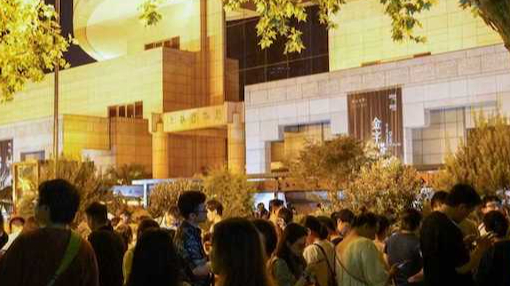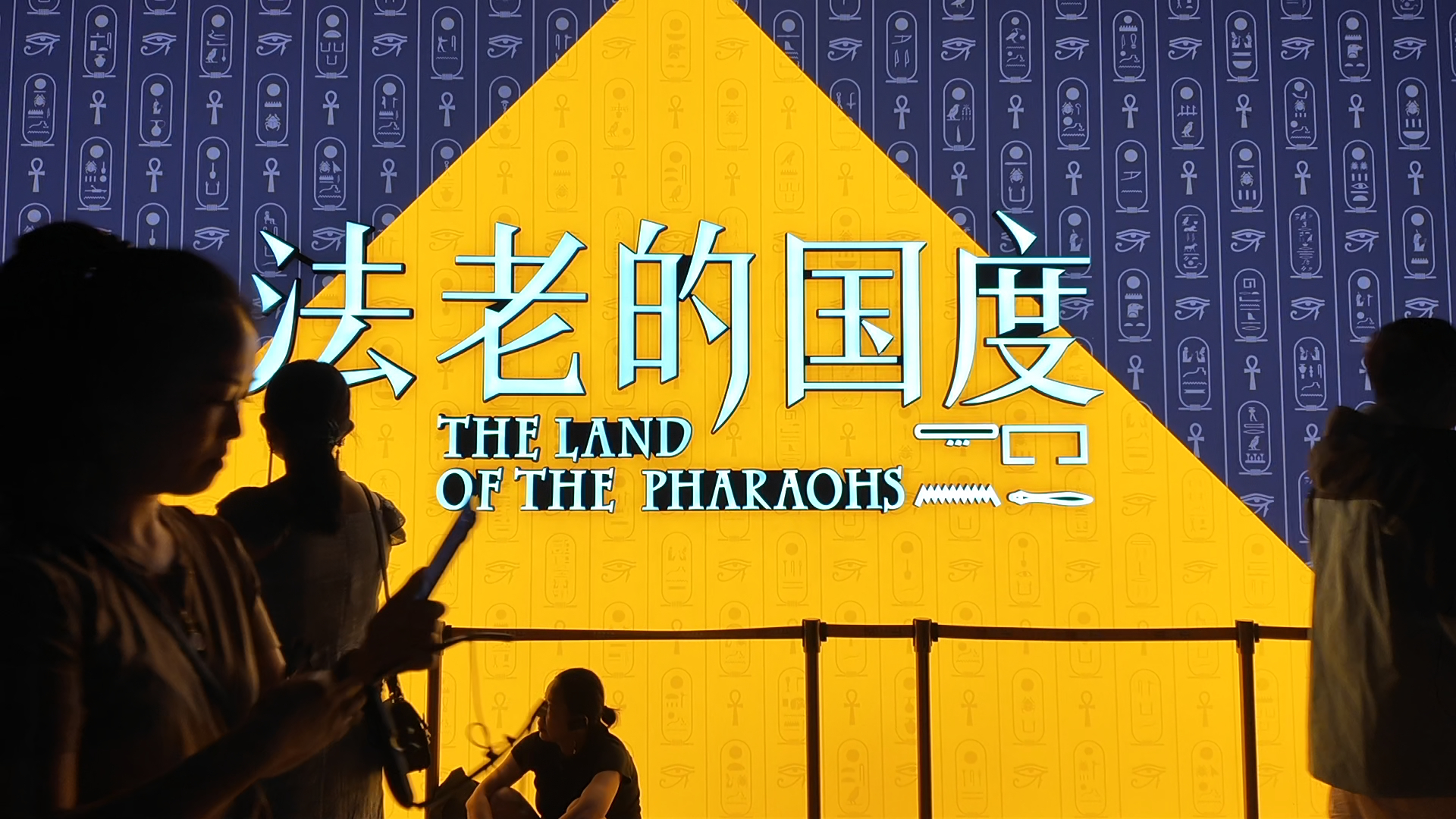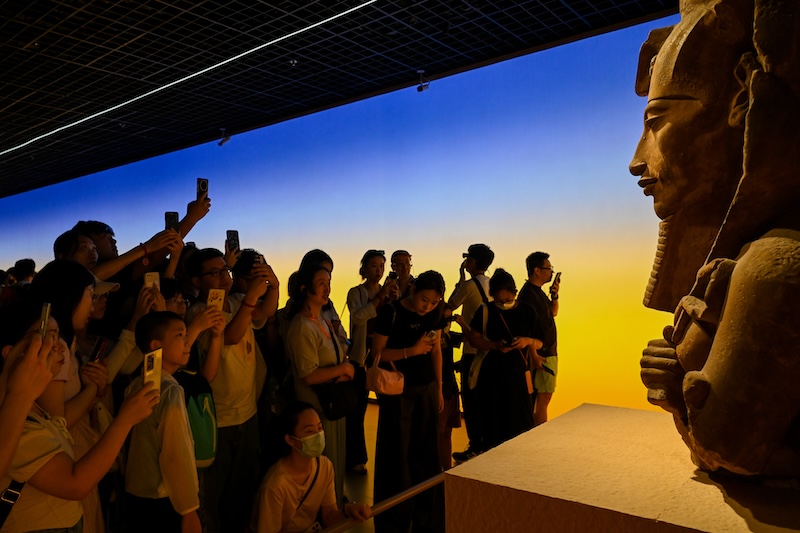
The Shanghai Museum's "Top of the Pyramids: Ancient Egyptian Civilization Exhibition", which lasted for 13 months, will end on August 17, 2025. This "phenomenal exhibition" spanning two hot summers is as hot as the summer temperature in Shanghai.
"Museums Never Sleep," a 168-hour, seven-day, seven-night event, officially began at midnight on August 11th. The Paper observed at midnight today that 3,000 visitors were queuing to see the exhibition, their enthusiasm undiminished . This unprecedented 168-hour opening also set an international record for museum hours. The Shanghai Museum stated that the "Ancient Egyptian Civilization Exhibition" has already attracted over 2.6 million visitors, and expects to exceed 2.7 million by the time of its closing, setting a new global record for attendance at a single, paid museum-specific exhibition of cultural relics.

At midnight, People's Square, where the Shanghai Museum is located, was silent except for the occasional chirping of summer insects. However, the lights in front of the Shanghai Museum were brightly lit, and there was a long queue - these were the 3,000 visitors who were attending the first late-night show (0:00-6:00 on August 11) of the 168-hour carnival series of the Ancient Egypt Exhibition.
"I've always wanted to see the Egyptian exhibition, but I couldn't buy daytime tickets before, so I bought this night show ticket. Besides, I'm used to staying up late, so it will definitely be a different experience!" an audience member told The Paper.

At midnight on August 11, in front of the Shanghai Museum

At midnight on August 11, people lined up in front of the Shanghai Museum
All 3,000 tickets for the first late-night session of the 168-Hour Carnival series (12:00 AM - 6:00 AM, August 11th) have sold out. With support from the Huangpu Traffic Police and other relevant departments and units, parking spaces around People's Square have been opened to accommodate nighttime visitors. Express lanes have also been added in front of the Shanghai Museum to facilitate entry.

In the early morning of August 11, inside the Shanghai Museum
During the seven consecutive days and nights of the exhibition, in addition to maximizing the accessibility of the exhibition hall to visitors, a series of exciting performances and immersive interactive activities will be held. Two carnival events, held on August 11th and 17th, will feature a parade of gods, Egyptian dance, Egyptian and Chinese drum performances, musicals, close-up magic shows, and a rendition of "The Moment of Farewell." From August 11th to 17th, a nighttime outdoor market will be held in the outdoor plaza at the south gate of the People's Square Pavilion from 5:30 PM to 9:30 PM daily.

At midnight on August 11, inside the Shanghai Museum exhibition hall
Before its official closing, the "Ancient Egyptian Civilization Exhibition" had already delivered impressive results: according to the Shanghai Museum, the exhibition expected to attract over 2.7 million visitors by its closing. Over 1,200 cultural and creative products were released, with sales totaling nearly 2.65 million. Revenue from cultural and creative activities and related products exceeded 400 million yuan. The Shanghai Museum also created a "one-stop" cultural and tourism experience program in conjunction with the exhibition, driving overall city consumption to over 20 billion yuan.

Visitors visit the statue of Akhenaten at the Shanghai Museum on July 19, 2024. (Photo by Zhu Weihui, a reporter from The Paper)
Among the many records set by the Ancient Egyptian Civilization exhibition, it's worth mentioning that it's widely recognized within the industry as one of the most challenging projects to organize. As Yan Haiying, the exhibition's chief curator and professor of history at Peking University, put it, "Looking back, only the Shanghai Museum could pull it off. The process was far more tortuous than one might imagine. While outsiders see the success and glamour, the underlying struggles were truly immense."
The popularity of the Egypt exhibition is primarily due to the meticulous planning of its content and the presentation of its blockbuster exhibits. This exhibition differs from previous exhibitions on ancient Egyptian civilization in China, which have often borrowed exhibits from European and American museums, presented through a Western perspective, and often served as canned exhibitions, planned by foreign parties and then handled by Chinese parties. This exhibition, however, is fully participated in by Chinese Egyptologists, who select artifacts from a Chinese perspective and borrow them directly from local Egyptian vendors. Borrowing artifacts from local Egyptian vendors is extremely challenging, both due to the high cost, which discourages most museums, and the stringent requirements and requirements.
"When negotiating the loan fee, the Shanghai Museum backed off because the price asked for by the Egyptian side was the highest standard that the Shanghai Museum psychologically expected, and they refused to give in at all. The loan fee of 5 million US dollars, plus the insurance, transportation and other costs, would cost them everything they had. I don't think any museum director would have the courage to agree to it." Yan Haiying admitted that she had backed down countless times due to too many difficulties during the preparation process. Fortunately, the leadership of the Shanghai Museum was firm, the Shanghai Museum was persistent, and it had a very gentle and hardworking team.

A seated statue of the goddess Ionite is seen in the "Realm of the Pharaohs" exhibition hall at the Shanghai Museum on July 16, 2024. (Photo by Zhu Weihui, The Paper)
The Shanghai Museum's exhibitions have consistently set industry benchmarks in both content and quality. The Egypt exhibition is positioned as a major exhibition, a comprehensive history of Egypt aimed at the Chinese public and providing a comprehensive understanding of the subject. The number of cultural relics on display must be sufficient, while also meeting both academic and aesthetic requirements.
But it was far from the best time to hold the exhibition. "First, Egypt's current economic situation was poor, and the cost of borrowing exhibitions was high. Secondly, the newly opened Museum of Egyptian Civilization and the Grand Egyptian Museum under construction had diverted artifacts from the National Museum of Egypt. Museums in countries like the United States and Spain were also lending exhibits, leaving us with very few artifacts to choose from." "From the initial worst possible time to a glimmer of hope, and then to gradually gaining confidence, it was a very long process."

On July 16, 2024, the painted human-shaped coffin of Ped-Amun was seen in the "Realm of the Pharaohs" exhibition hall at the Shanghai Museum. (Photo by Zhu Weihui, The Paper)
Chu Xiaobo, director of the Shanghai Museum, has also admitted many times that "if anyone had slacked off in the preparation of the Egypt exhibition, the exhibition would not have been possible."
Secondly, just as a good work is a collaborative effort between writer and reader, the creation of a phenomenal exhibition also requires audience interaction, participation, interpretation, and interpretation, imbuing the exhibition with new vitality. The diverse ways viewers experience the "Ancient Egyptian Civilization Exhibition" are a beautiful sight and an integral part of the exhibition.

When the "Egypt Exhibition" was at its peak, the exhibition hall was packed with people, and the audience's enthusiasm overflowed the screen.
Over the 300-plus days and nights of the Shanghai Museum's Egypt exhibition, many scenes have been captured in images, as well as some personal experiences. Two scenes that have left a deep impression on me are: at the height of the "Egypt exhibition," the exhibition hall was packed with people, their enthusiasm overflowing the screen; and as the exhibition progressed, more and more visitors appeared in the hall, holding guides or in groups of three or five wearing audio guides, listening attentively to the guides or human explanations, a scene of people calming down and studying seriously. The contrast between enthusiasm and calmness formed a new chapter.

Visitors shop for peripheral products at the Shanghai Museum's cultural and creative store on July 19, 2024. (Photo by Zhu Weihui, The Paper)
There are also various ways to enjoy the Egypt exhibition. With the hot sales of cultural and creative products, visiting the cultural and creative stores before visiting the Egypt exhibition has become a unique attraction of this exhibition. And taking home a popular Pharaoh "Tutu" plush toy after the exhibition is also something to be proud of.

On July 27, 2024, at the Shanghai Museum's People's Square Pavilion, visitors took photos with cats in the Cat Temple area of the "Secrets of Saqqara" exhibition hall. (Photo by Zhu Weihui, The Paper)
In conjunction with the Egyptian exhibition, the museum launched the world-first "Museum Cat Night," allowing visitors to bring their pet cats to the museum at night, creating a completely new way to experience the museum. While it's common abroad to consider dogs as family members, bringing them to restaurants and on vacations is quite common, bringing pets to exhibitions is rare. While this is a creative marketing move by the museum, it resonates with the psychology of contemporary young people and the unique nature of the exhibited artifacts, making it a hit and a truly exciting addition to the exhibition.
The ongoing 168-hour "Carnival," a sleepless night at the museum—an idea once seen only in movies, is also conceivably poised to spawn more "nighttime wandering" experiences within the exhibition halls. While many of these diverse exhibition viewing methods are driven by the museum's agenda, they have fostered a rich and vibrant ecosystem. The exhibition and the audience complement each other, and audience feedback has become an integral part of the exhibition. This, in turn, has sparked a rethinking of the museum's purpose: "Museums are not merely places for displaying artifacts, but also spaces for cultural exchange and social interaction."
"On the surface, it seems the Shanghai Museum's exhibition is so popular, but in reality, it's inseparable from the charm of Shanghai, the strong cultural and artistic consumption atmosphere that has been cultivated in Shanghai over the years, and the relevant policy environment." Shanghai Museum Director Chu Xiaobo once explained the reasons for the Egypt exhibition's popularity. "Shanghai has a good policy environment, which allows us to be confident and bold in trying some innovative measures."

The Shanghai Museum held a "Museum Adventure Night" themed on the ancient Egyptian civilization exhibition.
Some industry experts have distilled the Shanghai Museum's exhibitions and innovative initiatives into "content power", "innovation power" and "influence". The three-legged tripod and the resonance are the key winning strategies of the Shanghai Museum and the "Ancient Egyptian Civilization Exhibition". They believe that "Top of the Pyramids: Ancient Egyptian Civilization Exhibition" has gone from being an "Internet celebrity" ignited by instant traffic to a "long-lasting" event that has lasted for 13 months. It is a vivid presentation and typical representative of how cultural undertakings promote industrial development and boost the prosperity of the cultural market.
The exhibition attracted nearly 2.6 million visitors, nearly 70% of whom came from other provinces and cities, and over 70% of these visitors came to Shanghai specifically for this special exhibition, driving over 20 billion yuan in urban consumption. These figures demonstrate that the "Visiting a City for an Exhibition" campaign is no longer just a slogan; it is becoming a reality.

Ancient Egypt themed cruise
The Shanghai Museum's Ancient Egyptian Civilization exhibition has galvanized the entire city. From advertisements placed on buses, the "Shanghai Museum Exhibition Bus," to Ancient Egypt-themed cruises on the Huangpu River, the exhibition has not only generated buzz online but also become a major cultural event in Shanghai, highlighting the influence and impact of its culture. Visitors from other places, from the moment they set foot in the city, are enveloped by the exhibition's atmosphere, building from afar and gradually becoming more intense. By the time they reach the exhibition's venue, the Shanghai Museum in People's Square, they feel the call from across human civilizations.


